Rechargeable batteries are a more cost-effective and environmentally friendly alternative to standard AA and AAA batteries. Standard batteries contain heavy metals, including mercury, lead, cadmium, and nickel, which can contaminate the environment when if not properly disposed of.
Every year in the United States alone, nearly 3 billion dry-cell batteries are purchased to power radios, toys, cell phones, watches, laptops, and a variety of other electronics (1). Rechargeable batteries reduce the need to purchase single-use batteries and decrease the number of heavy metals that wind up in landfills and dispersed in the air.
Rechargeable batteries are not hard to find these days. They can be used in many devices including flashlights, headlamps, and handheld GPS. They are also handy to throw in a survival kit. Our list of the 10 Best Rechargeable Batteries will help you narrow down your choices and the Buyer’s Guide below provides a number of important criteria to consider when selecting a set of rechargeable batteries.
1. Sanyo Eneloop XX 4-Pack
This 4-Pack from Sanyo is great for anyone who needs rechargeable batteries that will perform in the cold environments. They have the ability to provide high performance in sub-zero temperatures down to -4 degrees Fahrenheit.
This rechargeable battery pack comes pre-charged and ready for immediate use. They can be recharged up to 500 times will maintain up to 75 percent of their charge after 1 year of non-use. These batteries can be recharged to full capacity every time and feature a nominal voltage of 1.2 volts.
2. Panasonic Eneloop 16-Pack
These NiMH batteries are great for anyone who needs batteries that are going to last for years. Each battery can be recharged a surprising 2100 times and maintain up to 70 percent of their charge after 10 years, if not in use.
These batteries are pre-charged at the factory using solar power and come with a 2000 milliamp-hour storage capacity and a 1900 milliamp-hour minimum. They also feature no memory effect, which means they can be recharged when fully or partially discharged. Panasonic also offers these rechargeable batteries in an AAA 16-Pack or in an AA + AAA pack with 4, 8, 12, or even 16 of each.
3. Energizer Rechargeable 4-Pack
Energizer’s 4-Pack of rechargeable batteries is the world’s first rechargeable battery made with 4 percent recycled batteries. Great for the most environmentally conscious battery user, these 2000 milliamp-hour capacity batteries come pre-charged and are ready for use upon opening.
These batteries can be recharged up to 1,000 times and will maintain a charge for nearly 12 months in storage. Energizer features an Extended Life Composition that ensures up to 5 years of usable battery life under typical usage rates. A single charge offers up to 8 hours of battery life for most handheld devices.
4. Powerex Imedion 4-Pack
A great battery for anyone looking for a bit more storage capacity and improved shelf life, the Powerex Imedion 4-Pack features 2600 milliamp-hour capacity batteries that will retain up to 85 percent of a charge after a year of storage.
Offering a voltage of 1.2V, these NiMH rechargeable batteries are pre-charged and ready to use. They can also be recharged hundreds of times over and this 4-pack of batteries comes with a battery case for safe and functional storage.
5. EBL High Capacity 8-Pack
Anyone searching for a rechargeable battery that will function with a variety of household devices should consider the EBL High Capacity 8-Pack. These NiMH batteries offer 2800 milliamp-hours of storage capacity and can be charged up to 1200 times.
Able to be charged when fully or partially drained, these batteries also features an improved low self-discharge that allow them to retain up to 75 percent of a charge after three years of non-use. Available with a two-piece battery storage case, these batteries arrive pre-charged and ready to use.
6. Lumsing 16-Pack
Perfect for a variety of household appliances as well as LED camping lights, flashlights, emergency radios, portable audio players, and more, this 16-Pack of NiMH rechargeable batteries from Lumsing offer voltage of 1.2V and a capacity of 2500 milliamp-hours.
Made from high-quality materials, these batteries can be recharged up to 1200 times. They also feature a small, lightweight design that makes them easy to transport and will retain high performance after 3-5 times charge and discharge cycle.
7. Duracell Duralock 12-Pack
Great if you need both AA and AAA rechargeable batteries, this 12-Pack of Duracell Duralock NiMH batteries offers 1.2V voltage and can be recharged up to 400 times. Once charged, these batteries provide up to 25 hours of power for a variety of devices.
Duralock technology includes a Long-life Ion Core that keeps unused batteries fresh and powered for up to 10 years in ambient storage. Batteries that come pre-charged will keep that charge for up to 12 months when not in use.
8. Amazon Basics 8-Pack
Amazon Basics sells this 8-pack of rechargeable batteries that provide a high number of recharge cycles and competitive storage capacity. They’re great for anyone looking for rechargeable batteries that are going to last for years, as they maintain 80 percent of a charge after a full year of non-use and are still fully rechargeable after three years.
Made in Japan, these batteries come pre-charged using solar energy and offer 1,000 recharge cycles. They come with a maximum storage capacity of 2000 milliamp-hours. Also great for your next trip to the mountains, these batteries are designed to maintain high power at low temperatures.
9. Tenergy High Drain 24-Pack
This 24-Pack of High Drain batteries from Tenergy comes with 12 AA and 12 AAA batteries. A money-saving and eco-friendly option, it’s designed for anyone that has a variety of everyday devices that are currently using too many single-use alkaline batteries.
The AA batteries offer a 2600 milliamp-hour storage capacity while the AAA batteries offer a 1000 milliamp-hour capacity. Both types of batteries can be recharged up to 1,000 times and often pay for themselves in less than 10 charges. With no memory effect, these batteries can be charged anytime, whether they are close to full or partially drained.
10. Goal Zero 4-Pack
This 4-pack of AA NiMH batteries is designed specifically for use with Goal Zero Guide 10 power packs and can be charged using the Nomad 7 or other Goal Zero solar panels. They are the perfect batteries for remote travelers reliant upon solar energy for most of their power needs.
With a lifecycle of 500 – 1,000 charges and a low self-discharge for longer shelf life, these batteries will power a variety of travel devices and retain their charge and rechargeability for years. They can sit on your shelf for 12 months and still keep up to 80 percent of their charge.
—
Buyer’s Guide
Perhaps surprisingly, the first rechargeable batteries were developed back in 1859 by a French physician named Gaston Planté (2). Planté’s early model was based on lead acid, a system that is still in use today but has been improved upon. Today’s batteries have drastically improved storage capacity, the ability to be recharged many times, and will retain a charge for months or years of non-use. Sometimes it might be more convenient to carry a portable charger instead of extra batteries.
Choosing the right set of rechargeable batteries isn’t overly complicated. We’ve put together this Buyer’s Guide to focus on several characteristics that will help you make your decision.
Storage Capacity
The first factor to consider when buying rechargeable batteries is how many milliamp-hours (mAh) each battery holds. It’s important to know that milliamp-hours do not directly translate to hours of charge, as milliamp-hours and ampere hours are units of electrical charge and not always direct indicators of how long a battery will last (3).
How long a specific battery will last depends on both its overall storage capacity and the amount of charge drawn by the device it powers. In general, however, a 3000 mAh battery is designed to last three times longer than a 1000 mAh battery (4).
Recharge Capability
Over time, even rechargeable batteries will lose their charge and ability to be recharged. While they will last much longer than disposable alkaline batteries, it’s important to consider how many times a rechargeable battery can be effectively charged before it begins to function below optimal capacity.
Many of the rechargeable batteries mentioned above can be recharged anywhere from a couple hundred times to more than 2,000 times and still maintain efficacy. This is a huge difference that can translate into some rechargeable batteries lasting years longer than others.
For example, a battery that offers an average of 10 hours of battery life and can be recharged more than 2,000 times will provide more than 20,000 hours of charge. In comparison, a battery with similar life but can only be recharged 500 times only offers 5,000 total hours of charge.
Shelf Life
Many rechargeable batteries are available in packs of 4, 8, 12, 16, 20, 24, and so on. Because rechargeable batteries are unlike traditional disposable batteries, however, more is not necessarily better.
Consider how often you change traditional batteries in your most frequently used devices. You’ll probably change batteries far less often as you convert to rechargeables. For this reason, it’s important to consider the shelf life of rechargeable batteries.
Many batteries suffer from a phenomenon known as ‘self-discharge.’ This means they will lose their charge over time even if unused. Rechargeable batteries actually tend to have a much faster discharge rate than alkaline batteries (5). This means that, if they’ve been sitting for a few years they will still be rechargeable but they may not retain a full charge for immediate use.
Frequently Asked Questions
The differences between rechargeable batteries can be minute, but there is a lot of information to learn about the specifications of these batteries. Here are some answers to many of the most frequently asked questions about rechargeable batteries.
What is mAh?
This term stands for “milliamp-hours.” Milliamps are used to measure the storage capacity of a battery. In general, the higher the milliamp rating, the longer a battery will hold a charge.
What do NiCd and NiMH stand for?
NiMH stands for nickel-metal hydride and NiCd stands for nickel-cadmium. Both are common types of batteries and both use nickel oxide hydroxide (NiOOH).
Which is better NiCd or NiMH batteries?
NiCd batteries tend to use Cadmium, which is actually a highly toxic heavy metal that causes environmental damage if not properly recycled. NiMH batteries include a cathode of nickel-hydroxide that is more benign than most lithium or cadmium batteries.
NiMH batteries also tend to have a higher capacity than NiCd batteries of the same size, but NiMH batteries do discharge nearly twice as quickly as NiCd batteries, sometimes in just one week. In general, NiMH batteries can’t handle the high rate of charges or discharges that NiCd batteries can.
Can I use a NiCd charger for NiMH batteries?
Yes, but it will produce less than optimal returns. Some older NiCd chargers may take up to 48 hours to charge new, high capacity NiMH batteries. Although these older chargers are unlikely to damage newer batteries unless you leave those batteries in the charger for weeks at a time, it probably won’t prove super convenient.
Do NiMH batteries need to be completely discharged before recharging?
No! These batteries can be recharged at any point without negative effect, regardless of their current state of charge.
Can older and newer batteries be mixed in a device?
This is not generally recommended. Most devices can only operate to the maximum level of the battery with the least amount of charge.
How often should you charge standard NiMH batteries?
These batteries should ideally be charged before every use if they have been off the charger for even days or more. If they are not regularly in use, they should still be charged every thirty days at minimum. Sitting uncharged for long periods of time is actually damaging to NiMH. The more you use them and subsequently charge them, the better the batteries will perform.
What is a smart charger?
Smart chargers use microprocessor circuitry to monitor certain battery parameters. These include temperature, voltage, and state of charge. These chargers use this information to determine when a battery has reached its charging capacity and charging should be terminated.
What is a trickle charge?
Trickle charging is a low rate charge used to replenish batteries battery capacity lost to self-discharge.
What is self-discharge?
Self-discharge is a phenomenon in batteries where internal chemical reactions can reduce the stored charge of the battery, even without a connection between electrodes. This phenomenon is known to decrease the shelf life of batteries and can cause batteries to have less than full charge upon first use.
Summary
Rechargeable batteries are the future of portable power. As we recognize the detriments of single-use batteries laden with hazardous heavy metals and improve recharge and storage capacity, rechargeable batteries will become cheaper, more efficient, and more popular. We hope that this article has helped you find rechargeable batteries that are right for you!
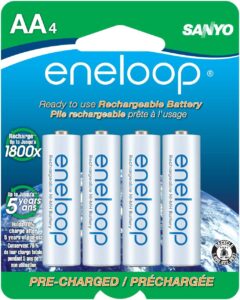
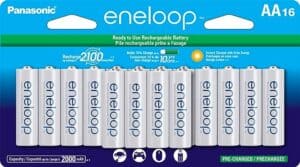

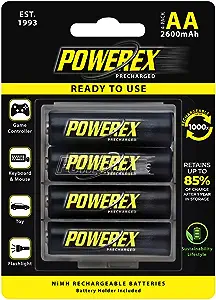
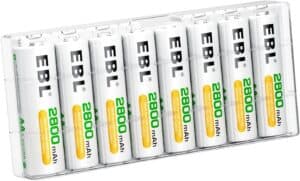
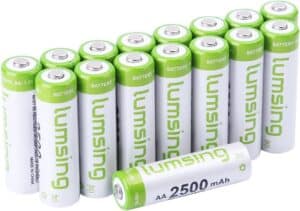
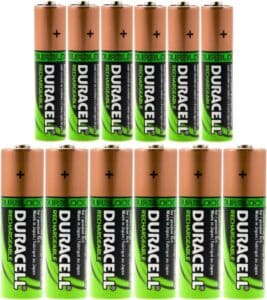
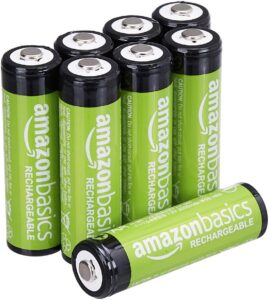
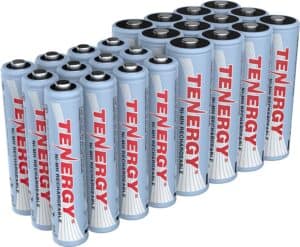
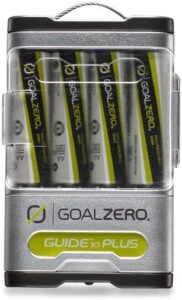



10 Comments
Streamlight ProTac 88040 HL review · April 24, 2018 at 10:29 pm
[…] flashlight isn’t rechargeable so if you use it on the high setting frequently you will go through a lot of batteries. It also is […]
Ranking the 10 Best Tactical Flashlights of 2018 · April 24, 2018 at 10:32 pm
[…] Life– Most tactical flashlights have the option of using a normal batter or a rechargeable battery. If you plan on using your flashlight frequently you will want to have a rechargeable battery with […]
Fenix PD35 Tactical Edition flashlight review · April 24, 2018 at 10:45 pm
[…] modes making it a versatile torch. The PD35 is compact but yet a powerful flashlight that uses rechargeable or non rechargeable batteries. The PD35 is a great flashlight and made the cut on our Best Tactical […]
SureFire G2X tactical flashlight review · April 24, 2018 at 11:04 pm
[…] large temperature variations. The batteries are also made in the USA. Some users chose to use rechargeable batteries instead of the ones provided. When used continuously on the high, 400-lumen beam, the batteries […]
Ecogear TK120 tactical flashlight review · April 24, 2018 at 11:22 pm
[…] that the light can use three-AAA batteries as well if you really need to use the light when the rechargeable batteries are not available. One customer wrote, “Awesome flash light. I like that it has multiple […]
J5 Tactical V1-Pro tactical flashlight review · April 24, 2018 at 11:34 pm
[…] V1-Pro is powered by one AA battery (not included) or a rechargeable battery can be used. The light is designed with optimum battery conservation. It is able to power the […]
Vizeri LED VZ460 tactical flashlight review · April 24, 2018 at 11:50 pm
[…] is another flashlight that gives you the option of using rechargeable batteries or regular which is the kind of flexibility we love. It either runs on AAA batteries or CR123 […]
Helotex G4 tactical flashlight review · April 25, 2018 at 12:01 am
[…] Helotex G4 has dual power capability to run either on two CR123 batteries or a single 18650 rechargeable battery. This is always a nice feature in case you need to use the light and have been unable to charge it. […]
Solaray Pro ZX-1 tactical flashlight review · April 25, 2018 at 10:46 pm
[…] a tactical backpack. Capable of producing up to 1200 lumens, with 5 light modes and the option for rechargeable batteries or 3-AAA. Weighing only 5 oz and 6” long make this a great EDC […]
Ranking the 10 Best Headlamps · May 3, 2018 at 9:19 pm
[…] no. While rechargeable batteries have a much longer life than most traditional alkaline batteries, they still have a useful life. In […]
Comments are closed.